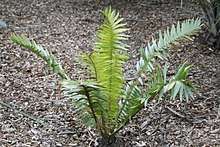Encephalartos septentrionalis
Encephalartos septentrionalis, the Nile cycad, is a species of cycad in South Sudan, northern Uganda, northern Democratic Republic of the Congo (in the Okapi Faunal Reserve), and the interior of the Central African Republic.[1]
| Encephalartos septentrionalis | |
|---|---|
 | |
| Scientific classification | |
| Kingdom: | Plantae |
| Clade: | Tracheophytes |
| Division: | Cycadophyta |
| Class: | Cycadopsida |
| Order: | Cycadales |
| Family: | Zamiaceae |
| Genus: | Encephalartos |
| Species: | E. septentrionalis |
| Binomial name | |
| Encephalartos septentrionalis Schweinf. ex Eichler | |
Description
It is a cycad with a globose stem, at least partly underground, up to 2 m high and with a diameter of 25-30 cm.
The leaves, pinnate, 90–150 cm long, are arranged in a crown at the apex of the stem and are supported by a 2.5–5 cm long petiole, without thorns; each leaf is composed of 40-50 pairs of lanceolate leaflets, with entire margins, on average xx-xx cm, greyish-green in color.
It is a dioecious species with male specimens that have up to 8-10 ellipsoid cones, 12–20 cm long and 6–8 cm broad, pedunculated, and female specimens with solitary cylindrical, pendulous cones, 23–35 cm long and with a diameter of 18–20 cm, yellowish-brown in color when ripe.
The seeds are coarsely ovoid, covered by a reddish-colored sarcotesta.[2]
References
- Bösenberg, J.D. (2010). "Encephalartos septentrionalis". IUCN Red List of Threatened Species. 2010: e.T41950A10609549. doi:10.2305/IUCN.UK.2010-3.RLTS.T41950A10609549.en. Retrieved 15 January 2020.
- "Encephalartos septentrionalis". PlantNET Home Page - National Herbarium of New South Wales. Retrieved 2019-09-18.
External links


